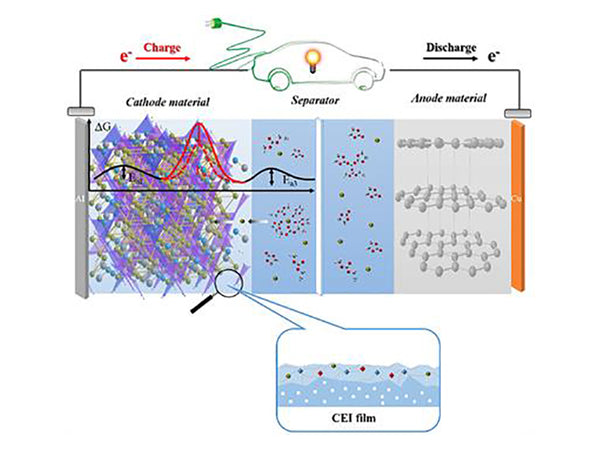
main content:
1. Improve electrolyte thermal stability through additives

The boron-based anion acceptor tris (pentafluorophenyl) borane [tris (pentafluorophenyl) borane (TF-PB)] and tris (pentafluorophenyl) borate [tris (pentafluorophenyl) borate (TFPBO)] are two types It can be used as an electrolyte additive for lithium-ion batteries. These two additives can improve the ionic conductivity of simple lithium salts such as LiF, CF3CO2Li and C2F5CO2Li in organic solvents. Several lithium salts are used in EC-PC-DMC (1:1:3, volume ratio) solutions with TPFB additives. The electrochemical windows in the media have reached 5V, 4.76V, and 4.96V, respectively. In contrast, the electrochemical stability of TFPBO is low. In addition, the thermal stability of pure TFPB is also better than that of TFPBO. The TPFB-based electrolyte has good cycle efficiency and cyclability in Li/LiMn2O4. The TFPBO-based electrolyte was measured in a Li/LiINiO2 battery, and the battery gave high discharge capacity and good cycle efficiency. After many cycles, the capacity retention capacity of the battery using TFPB is better than that of the battery using TFPBO-based electrolyte. The study of using a strong anionic complexing agent TFPPB to inhibit the thermal decomposition of LiPF6 electrolyte shows that the addition of 0.1 mol/L TFPPB can maintain the electrochemical stability of LiPF6 electrolyte at 55°C within one week, without using it under the same conditions The electrochemical stability of the electrolyte of the additive is severely reduced. The Li/LiMn2O4 battery in the LiPF6 electrolyte containing 0.1 mol/L TPFPB additive showed superior capacity retention and cycle efficiency at 55°C than the battery without additives. These data indicate that TFPPB additives improve the thermal stability of LiPF6 electrolyte.
2. Improve the wettability between the electrolyte and the electrode surface

②Improve the wettability between the electrolyte and the electrode surface
In order to ensure that the electrolyte is in full contact with the electrode material and the diaphragm, so that the distance between the lithium ion and the electrode material is the shortest and smoothly pass through the micropores of the polymer diaphragm, the electrolyte must also have a good wetting effect on it. The mathematical model of capillary liquid movement is used to analyze the wettability of LiCoO2 and MCMB electrodes in non-aqueous electrolyte. The results show that it is more difficult to wet LiCoO2 electrodes compared with MCMB in the same electrolyte composition. The wetting of the porous electrode is mainly controlled by the penetration and spreading performance of the electrolyte in the micropores. The electrolyte penetration is determined by the viscosity. The spread of the electrolyte is controlled by surface tension. Due to changes in the viscosity and surface tension of the electrolyte, the composition of the organic solvent and the concentration of the lithium salt can affect the wettability of the porous electrode. Increasing EC and/or lithium salt will worsen the spreading and permeability of the electrolyte. In addition, careful control of the pressure helps to increase the surface area of the solid-liquid interface. AC impedance spectroscopy studies have shown that vacuuming before injecting electrolyte can achieve maximum wetting within a few hours. If the vacuum is not applied, it may take several days to achieve full wetting.
Trace amounts of HF acid and water in the electrolyte play an important role in the formation of SEI film. Excessive water and acid content will not only cause the decomposition of LiPF6, but also destroy the SEI film. After 0.5% water is added to the electrolyte, the lithium-intercalation step that originally appeared in the discharge curve of the graphite electrode no longer appears, indicating that the SEI generated when an aqueous electrolyte (1mol/L LiBF4 EC/γ-BL) is used The film is thicker than that produced in a non-aqueous electrolyte, which prevents lithium from being embedded in the graphite layer. Add lithium or calcium carbonate, Al2O3, MgO, BaO, etc. as additives to the electrolyte. They will react with a small amount of HF in the electrolyte to prevent its damage to the electrode and its catalytic effect on the decomposition of LiPF6. Improve the stability of electrolyte. For example, adding LiCl, LiF, LiBr and LiI to a 1mol/L LiPF6/EC+DEC electrolyte containing 5000μg/g water can inhibit the reaction of LiPF6 with water. When adding 0.1 mol/L LiCl, the LiPF6 electrolyte will not react with water within 50h. DSC measurement showed that after adding LiCl, the heat released by the reaction of LiPF6 at 265°C remained unchanged within 48h. In addition, carbodiimide compounds can form weaker hydrogen bonds with water through hydrogen atoms in the molecule, which can prevent water from reacting with LiPF6 to produce HF.















